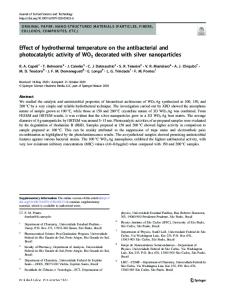Study of the photocatalytic activity of irradiated WO 3 microparticles
- PDF / 3,410,971 Bytes
- 11 Pages / 595.276 x 790.866 pts Page_size
- 85 Downloads / 395 Views
Study of the photocatalytic activity of irradiated WO3 microparticles Artem L. Kozlovskiy1,2,3 · Maxim V. Zdorovets1,2,4 Received: 21 May 2020 / Accepted: 20 July 2020 © Springer-Verlag GmbH Germany, part of Springer Nature 2020
Abstract The work is devoted to the study of the effect of irradiation of commercial W O3 microparticles with low-energy helium ions on the structural properties and photocatalytic activity during the decomposition of organic dyes. The irradiation fluences of 1 × 1013–1015 ion/cm2 were selected so that the number of defect overlap areas corresponded from 10 to 1000, but helium inclusions were not formed. It was found that with an increase in the radiation dose to 1015 ion/cm2, partial degradation of the structural properties of microparticles is observed due to destruction of the surface layer and subsequent amorphization. Photocatalytic tests showed that for the initial microparticles not exposed to irradiation, the degree of decomposition of the indigo carmine dye was no more than 45–50% after 300 min, while for irradiated microparticles with a fluence of 1 013 ion/ cm2, complete decomposition was observed after 200 min, and for microparticles irradiated 1 014 ion/cm2, complete dye decomposition is observed after 270 min. Partial amorphization upon irradiation with 1015 ion/cm2 leads to a decrease in the degree of decomposition and a decrease in photocatalytic activity. In the case of decomposition of the congo red dye, the initial microparticles amounted to no more than 20% of the initial composition. For modified microparticles, an increase in the degree of decomposition is observed up to 45–50%. Keywords Microparticles · Photocatalysis · Radiation defects · Structural changes · Helium ions
1 Introduction In recent years, more and more attention has been paid to oxide or nitride micro- and nanostructured materials, as well as to various forms of their compounds, the interest in which is determined by their physicochemical, structural, strength and corrosion properties, which determine their huge application potential [1–3]. At the same time, the possibility of varying structural properties and morphology, as well as changing the specific surface area and particle size, opens * Artem L. Kozlovskiy [email protected] Maxim V. Zdorovets [email protected] 1
Engineering Profile Laboratory, L.N. Gumilyov, Eurasian National University, Nur‑Sultan 010008, Kazakhstan
2
Laboratory of Solid State Physics, The Institute of Nuclear Physics, Almaty 050032, Kazakhstan
3
Laboratory of Additive Technologies, Kazakh-Russian International University, Aktobe 030006, Kazakhstan
4
Department of Intelligent Information Technologies, Ural Federal University, 620075 Yekaterinburg, Russia
up wide opportunities for researchers to use oxide microand nanostructures in solving technological problems, such as photocatalysis, microelectronics, wastewater treatment, solar energy [4–7]. Among the oxide compounds, tungsten oxide (WO3) with a high melting point, good resistance to most aggres
Data Loading...











